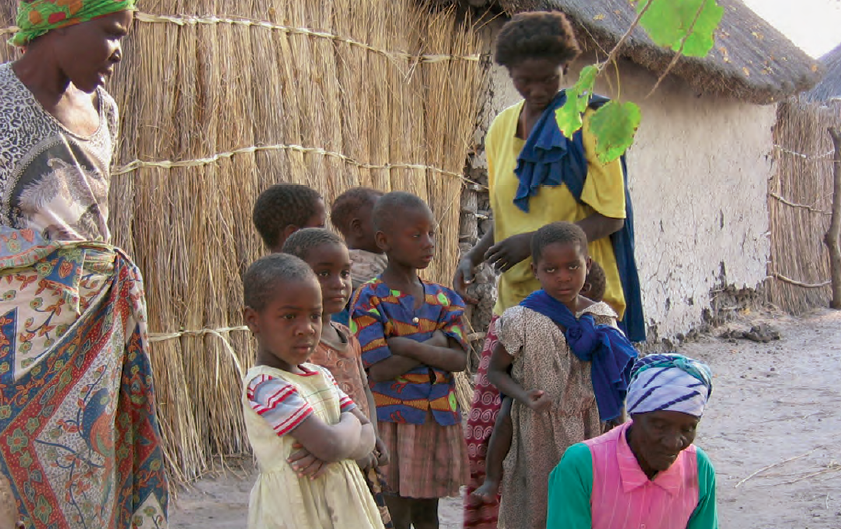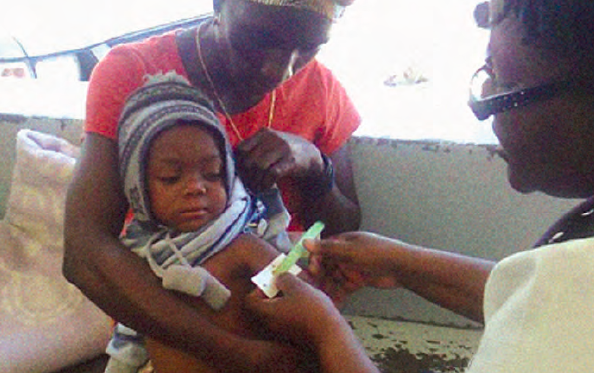Lessons from Namibia’s Nutrition Assessment Counselling and Support Programme for addressing child, adolescent and maternal undernutrition and HIV/AIDS
 Hilde Liisa Nashandi and Marijke Rittmann
Hilde Liisa Nashandi and Marijke Rittmann
Hilde is the Senior Health Programme Officer in the Food and Nutrition Sub-Division of the Ministry of Health and Social Services in Namibia.
Marijke is a nutritionist who previously worked at the Ministry of Health and Social Services in Namibia. She is currently studying for her Masters at Rutgers University, New Jersey, USA.
Namibia has an estimated population of 2.1 million. Although Namibia is food secure, many rural households are not able to produce or purchase enough food for consumption. According to the Namibia Demographic Health Survey 2013, stunting (low height for age) is 24% and wasting (low weight for height) is 6%. National HIV prevalence in Namibia is estimated at 18.2 percent (2012) though this varies from 39 percent to 8 percent across the regions.
To address the problem of severe acute malnutrition (SAM) in children under five years of age, the Ministry of Health and Social Services (MoHSS) developed an Integrated Management of Acute Malnutrition (IMAM) programme in 2008, focused on assessment and treatment of SAM. The carers of children with moderate acute malnutrition (MAM) were provided with counseling and encouraged to prepare nutritious local foods for their child but were not admitted to specific treatment programmes. However, there were many MAM cases that developed SAM, some with complications. To address this issue, the MoHSS launched the Nutrition Assessment Counseling and Support (NACS) programme in 2010, offering wider services in nutrition, to replace the IMAM programme. The NACS has been funded by a number of donors though today, it is funded by the Global Fund, Centers for Disease Control (CDC) and the Government.
NACS provides routine universal nutrition assessment and treatment for all MAM and SAM children, pregnant women and post partum women 6 months after delivery and people living with HIV/AIDS (PLHIV). NACS is currently being implemented in all regions and most clinics in the country. Most health workers, including doctors and nurses, have been trained to effectively screen, treat, refer and provide follow-up services for SAM and MAM children, PLHIV, and pregnant and post-partum women for up to six months.
Nutritional assessment
The NACS nutrition assessment is conducted on all those visiting health facilities or accessing outreach services. Nutritional status is assessed using mid-upper-arm circumference (MUAC) or body-mass-index (BMI) for adults, weight for height (WFH) and MUAC for children, and MUAC for pregnant and post-partum women. In addition, dietary assessment is conducted to inform nutritional counseling. Regular weighing is conducted to monitor the effectiveness of care, treatment, and nutrition interventions and to prescribe medicine doses. During home visits by the Community Health Care Providers, assessments are done with MUAC. Individuals found to have a low MUAC are referred directly to the nearest health facility for follow up.
Nutritional Treatment
Treatment for SAM consists of take-home rations of Ready-to-Use Therapeutic Food (RUTF) and Ready-to-Use Supplementary Food (RUSF) for MAM. These are prescribed to individuals for a limited time, based on clear admission and discharge criteria. These nutrition products are provided alongside nutritional counseling by the health workers at the health facility.
Programme review
A review of the NACS was conducted in November 2012 with the assistance of UNICEF, FANTA, CDC and the Global Fund. Key findings from the report include:
- Most providers interviewed had received supportive supervision, usually from the national level, but indicated the need for closer mentoring and supervision from the district level.
- Most facilities were well equipped for nutrition assessment.
- Storage conditions for specialized food products were inadequate in most of the facilities, and more than one-half of staff interviewed reported stock-outs and late delivery, although no facility had expired or damaged commodities.
- As a result of staff shortage, NACS providers assessed only clients who looked malnourished because they were too busy to assess each client on each visit.
- The monthly and consumption report were either incorrectly filled in or partly filled in due to poor supervision and on the job training.
One of the key challenges, which likely contributed to some of the findings raised in the report, was poor management and supervision from district and regional levels. This is reportedly due to the fact that staff at these levels were not adequately trained in how to manage and supervise the programme. This gap has resulted in a lack of implementation support for facility-based staff, including how to correct mistakes and encourage increased caseload detection and coverage.
 Learning from others
Learning from others
In considering how to improve the NACS, national level MoHSS programme officers noted that the Extended Programme of Immunisation (EPI) was a well managed and supported programme at all levels. EPI indicators are integrated in the Health Information System (HIS) and data entered by the Information Officers in the Ministry. Key factors underpinning the success of the EPI programme include:
- A special training for regional and district staff on how to manage, set targets, report and support the EPI programme.
- Regular meetings with key focal people to look at progress based on data reported.
- Targets are developed by the regions themselves and poor performance is compared against their own target.
- Regular feedback regarding performance through mapping of performance.
- Facilities have visual representation of their performance in the form of charts and tables for all to see.
- There are simple reporting forms.
Based on the review and the EPI experience, in 2013-2014 the NACS programme undertook the following activities to improve its management and supervision.
- Integration of NACS indicators into the Ministry’s HIS was agreed with key stakeholders.
- Nutrition products (i.e. RUTF, RUSF and Combined Minerals and Vitamins) have been approved to be included in the Namibia Essentials Medicines list and to be procured by the Ministry through the Central Medical Store.
- Training on management for mid-level staff was conducted and trainings for health workers (including nurses) has been provided. Training on NACS will be integrated into the Nursing curriculum of all Registered and Enrolled Nurses in the country. NACS training materials have been revised to be more user-friendly.
- Regular supportive supervisory visits were agreed to be important at all levels.
- Indicators such as weight for age, length for age and weight for length/height have been added to the revised child health passport for children under 5 which will be implemented in all health facilities in 2015/ 2016.
- NACS reporting forms were simplified.
Conclusion and Way Forward
The MoHSS is continuing to geographically expand the NACS programme so that it will be implemented in all the health facilities in the country. There is political commitment to improve and expand capacity for the implementation of NACS and specifically, on-the-job training and possibly digital video conferencing sessions will be held for all regions. The Ministry continues to advocate for building human resource capacity in nutrition at the pre-service training level. Additionally, there are plans to improve NACS data management by developing standard operating procedures for reporting and there is some consideration of moving towards electronic reporting. Finally, the MoHSS aims to establish a referral system for NACS clients who successfully recover from the treatment of acute malnutrition yet are in need of economic and livelihood support. These individuals will be referred by health workers to the government-supported drought relief programmes and donor funded income-generating projects.

